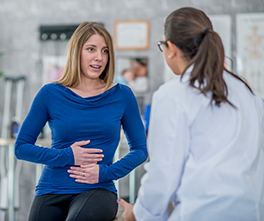When your gut feels sluggish, a little movement might be just what you need.
Physical activity can help get things moving — literally. Michel DeVos, PT, DPT a physical therapist with Hartford HealthCare Rehabilitation Network, shares a few simple exercises you can try today.
Why movement helps your digestion.
If your digestion feels off, gentle movement can make a big difference.
Here’s why, according to DeVos:
- Relieves constipation: Physical activity activates the muscles in your digestive tract, helping food and waste move more efficiently.
- Eases bloating: Exercise reduces gas and waste buildup, relieving that full, uncomfortable feeling.
- Improves Irritable Bowel Syndrome (IBS): Regular movement may help ease IBS symptoms like cramping, bloating, gas, and irregular bowel movements.
- Prevents stress-related gut issues: Exercise is a natural stress reliever — and less stress can lead to fewer digestive flare-ups.
> Related: 9 Common Causes of Constipation
Get things moving with these 5 exercises.
We get it – moving might be the last thing you want to do when your gut’s feeling off. But – just a few minutes of gentle movement a couple of times a day can help.
Here’s what DeVos recommends to help ease digestive symptoms.
1. Child’s pose.
This relaxing stretch targets your spine, hips and lower back.
“This simple pose also helps improve digestion by stimulating the internal organs in the abdomen,” says DeVos. “As a bonus, it can help reduce stress and fatigue during a busy day.”
Try it: Kneel on the floor and sit back onto your heels. Stretch your arms forward and lower your chest towards the ground.
2. Cat cow.
This slow, rhythmic movement engages your core while gently stretching your spine.
“Cat cow is great for digestion since it relieves tension along the spine and massages other internal organs like the kidneys and liver,” says DeVos.
Try it: Start on your hands and knees. As you inhale, arch your back downwards and lift your head. Then, round your back and tuck your chin to your chest as you exhale.
3. Knees up to the chest.
Pulling your knees in applies gentle pressure to your abdomen, easing gas and bloating.
“This one’s simple but effective,” says DeVos. “Try it before bed or right when you wake up.”
Try it: Lie on your back and hold your knees at your chest for several breaths.
> Related: The Best (and Worst) Foods for Keeping Your Gut Moving
4. Thread the needle.
This gentle twist opens up your back, shoulders and chest while loosening tight muscles through your torso.
“Twisting motions are great for your gut,” says DeVos. “They help loosen tension that might be slowing down your digestion.”
Try it: Start on your hands and knees. Slide one arm under your opposite arm, while lowering your shoulder and head to the floor, twisting through your torso.
5. Diaphragmatic breathing.
Sometimes, the best way to support digestion is just to breathe – but with intention.
“Think of your breath like an umbrella opening in all directions – front, sides and back,” says DeVos. “It’s one of the most powerful tools you have to help your digestive system work better.”
Try it: Breathe in through your nose and out through your mouth while expanding your belly, ribcage and back.
Need more personalized help?
Your digestive system might take a bit to respond to changes – so be patient.
“It takes time to heal,” says DeVos. “But if your at-home work isn’t improving things, talk to a pelvic health physical or occupational therapist. We can help get you on the right track.”



